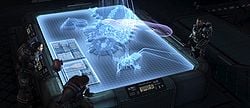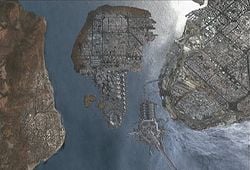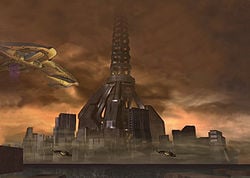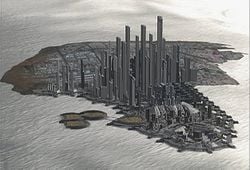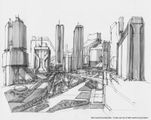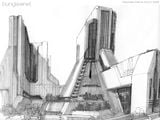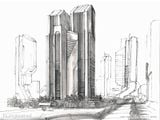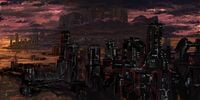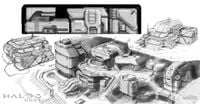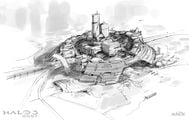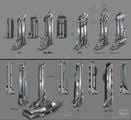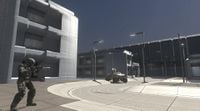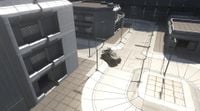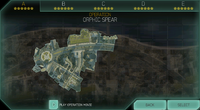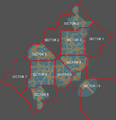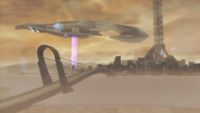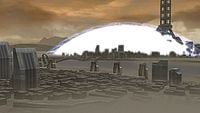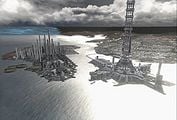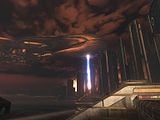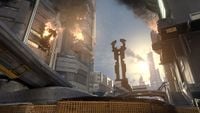New Mombasa: Difference between revisions
From Halopedia, the Halo wiki
BaconShelf (talk | contribs) |
CMDR RileySV (talk | contribs) (Fixed up the citations, made the page more consistent, added more information and did some reorganizing.) |
||
| Line 7: | Line 7: | ||
*New Mombasa- 24th Century | *New Mombasa- 24th Century | ||
|destroyed=[[2552#October|October 21, 2552]] | |destroyed=[[2552#October|October 21, 2552]] | ||
|notable= [[Battle for Earth]] | |notable=[[Battle for Earth]] | ||
*[[Battle of Mombasa]] | |||
|notable-title=Notable events | |notable-title=Notable events | ||
|governance= [[East African Protectorate]] | |governance= [[East African Protectorate]] | ||
}} | }} | ||
'''New Mombasa''' was a major port city and industrial center on [[Mombasa|Mombasa Island]] in south [[Republic of Kenya|Kenya]], in the [[East African Protectorate]] on [[Earth]]. | '''New Mombasa''' was a major port city and industrial center on [[Mombasa|Mombasa Island]] in south [[Republic of Kenya|Kenya]], in the [[East African Protectorate]] on [[Earth]]. | ||
A dominant feature of the city skyline was the [[Mombasa Tether]], located on the mouth of the river north of the island. [[Old Mombasa]] surrounded the metropolis on all sides on the mainland. Like Earth's other [[Space elevator|tether]] cities, New Mombasa's infrastructure was managed with the help of a second generation [[Dumb AI|"dumb" AI]], the [[Superintendent]]. | A dominant feature of the city skyline was the [[Mombasa Tether]], located on the mouth of the river north of the island. [[Old Mombasa]] surrounded the metropolis on all sides on the mainland. Like Earth's other [[Space elevator|tether]] cities, New Mombasa's infrastructure was managed with the help of a second generation [[Dumb AI|"dumb" AI]], the [[Superintendent]].<ref name="evg">''[[Halo: The Essential Visual Guide]]'', p. 191</ref><ref>''[[Bungie.net]]'', [http://halo.bungie.net/projects/odst/guide.aspx Halo 3: ODST Field Guide]</ref> | ||
It was the main target of the initial [[Covenant]] attack during the [[Battle for Earth]].<ref name="outskirts"> | It was the main target of the initial [[Covenant]] attack during the [[Battle for Earth]].<ref name="outskirts">''[[Halo 2]]'', campaign level, [[Outskirts]]</ref> The city was invaded, occupied, and destroyed in the course of the conflict. | ||
==History== | ==History== | ||
===Mombasa=== | ===Mombasa=== | ||
Mombasa had always been an important port of the [[Wikipedia:Indian Ocean|Indian Ocean]] trade routes and was captured and recaptured countless times by a variety of powers including [[Wikipedia:Portugal|Portugal]], the [[Wikipedia:United Kingdom|United Kingdom]], and various Arab forces. This violent history led to its [[Swahili]] nickname "Kisiwa Cha Mvita", or "Island of War". The city became part of the independent nation of [[Wikipedia:Kenya|Kenya]] in the 20th century. During this era, Mombasa became a tourist destination, boasting numerous resorts and clean, white beaches. It was also important as a port city, connecting East Africa to the Indian Ocean.<ref>[[Wikipedia:Mombasa|''Wikipedia'': Mombasa]]</ref> | |||
Mombasa had always been an important port of the [[Wikipedia:Indian Ocean|Indian Ocean]] trade routes and was captured and recaptured countless times by a variety of powers including [[Wikipedia:Portugal|Portugal]], the [[Wikipedia:United Kingdom|United Kingdom]], and various Arab forces. This violent history led to its [[Swahili]] nickname "Kisiwa Cha Mvita", or "Island of War". The city became part of the independent nation of [[Wikipedia:Kenya|Kenya]] in the 20th century. During this era, Mombasa became a tourist destination, boasting numerous resorts and clean, white beaches. It was also important as a port city, connecting East Africa to the Indian Ocean. | |||
===Formation of New Mombasa=== | ===Formation of New Mombasa=== | ||
[[File:Orbital Elevator.jpg|thumb|right|250px|The [[Mombasa Tether]], an iconic feature of New Mombasa.]] | [[File:Orbital Elevator.jpg|thumb|right|250px|The [[Mombasa Tether]], an iconic feature of New Mombasa.]] | ||
In [[2302]], due to its economic stability and prominent location, New Mombasa—at that time the world's busiest sea port—was chosen to be Earth's first [[space elevator]] city. The elevator transformed the city; New Mombasa became one of the most important cities on Earth.<ref name="waypoint"> | In [[2302]],<ref name="fieldguide"/> due to its economic stability and prominent location, New Mombasa—at that time the world's busiest sea port—was chosen to be Earth's first [[space elevator]] city. The elevator transformed the city; New Mombasa became one of the most important cities on Earth.<ref name="waypoint">''[[Halo Waypoint]]'', "Space Elevator" article (Archived on [https://web.archive.org/web/20111007185941/http://halo.xbox.com/en-us/intel/theuniverse/locations/gallery/space-tether/e9b2f438-9b5b-477e-8e52-d4e6801e9d5b Archive.org])</ref> | ||
Over the next eleven years the city experienced explosive growth, but nothing compared to what followed. The city grew out as well as up, its urban sprawl unequaled throughout the continent.<ref name="fieldguide">[http://halo.bungie.net/projects/odst/guide.aspx | Over the next eleven years the city experienced explosive growth, but nothing compared to what followed. The city grew out as well as up, its urban sprawl unequaled throughout the continent.<ref name="fieldguide">[http://halo.bungie.net/projects/odst/guide.aspx ''Bungie.net'': Halo 3: ODST Field Guide: New Mombasa]</ref> | ||
By [[2430]], New Mombasa had absorbed the entire island and many of the surrounding towns, which became overrun by residents of Mombasa. The switch of name was never official, and though many of the neighborhoods within direct line of sight to the Mombasa Tether still distributed newspapers and chatter directories under their previous names, all municipalities within a 74-kilometer radius of the island became referred to as "[[Old Mombasa]]".<ref name="fieldguide"/> | |||
===The Covenant invasion=== | ===The Covenant invasion=== | ||
[[File:H3ODST PreparetoDropCinematic.jpg|250px|thumb|left|A hologram of New Mombasa, with ''Solemn Penance'' above it.]] | [[File:H3ODST PreparetoDropCinematic.jpg|250px|thumb|left|A hologram of New Mombasa, with ''Solemn Penance'' above it.]] | ||
{{Quote|This is the only place on Earth the [[Covenant]] decided to land. That [[Prophet of Regret|Prophet]] is going to tell us why.|[[Fleet Admiral]] [[Terrence Hood]]<ref name="outskirts"/>}} | |||
{{main|Battle of Mombasa}} | {{main|Battle of Mombasa}} | ||
On [[2552#October|October 20th, 2552]], a [[Fleet of Sacred Consecration|small fleet]] of Covenant [[capital ship]]s exited [[Slipstream space|Slipspace]] just off of Earth's [[Orbital defense platform|defensive network]]. During the ensuing battle, a Covenant {{Class|CAS|assault carrier}}, ''[[Solemn Penance]]'' breached the orbital fortifications and made its way to the surface. The ship, which carried the Covenant [[Hierarchs|Hierarch]] known as the [[Prophet of Regret|High Prophet of Regret]], took position over | On [[2552#October|October 20th, 2552]], a [[Fleet of Sacred Consecration|small fleet]] of Covenant [[capital ship]]s exited [[Slipstream space|Slipspace]] just off of Earth's [[Orbital defense platform|defensive network]]. During the ensuing battle, a Covenant {{Class|CAS|assault carrier}}, ''[[Solemn Penance]]'' breached the orbital fortifications and made its way to the surface. The ship, which carried the Covenant [[Hierarchs|Hierarch]] known as the [[Prophet of Regret|High Prophet of Regret]], took position over the [[Uplift Nature Reserve]].<ref name="upliftreserve"/> In Old Mombasa, [[Outskirts announcements|announcements in Swahili]] were broadcast over a public address system. These propagandist announcements encouraged New Mombasa's citizens to fight against the invading "alien zealots"; even though there was very little truth to these announcements as they were only intended to increase the morale of the population.<ref>[http://nikon.bungie.org/misc/h2dialogue.html?cat=swahili ''Halo.Bungie.org'': Halo 2 Dialogue Snippets - Snippets of Swahili]</ref> | ||
[[File:H3ODST NewMombasa.jpg|thumb|right|The rainy streets of New Mombasa, reduced to a ghost town.|200px]] | [[File:H3ODST NewMombasa.jpg|thumb|right|The rainy streets of New Mombasa, reduced to a ghost town.|200px]] | ||
Later that day, [[Master Chief Petty Officer]] [[John-117]] was deployed into [[Old Mombasa]] to assist [[United Nations Space Command|UNSC]] forces to liberate the city from the Covenant. After fighting through the maze-like streets of the mainland, the Master Chief crossed the empty beach below the seawall and then entered the highway system and the bridge to New Mombasa. After a series of quick battles in a [[Kilindini Park Cultural Center|public park]] and the city streets, the Chief boarded and destroyed a Covenant [[Type-47A Scarab|Scarab]] as it passed through the city's artificial canals. | Later that day, [[Master Chief Petty Officer]] [[John-117]] was deployed into [[Old Mombasa]] to assist [[United Nations Space Command|UNSC]] forces to liberate the city from the Covenant. After fighting through the maze-like streets of the mainland, the Master Chief crossed the empty beach below the seawall and then entered the highway system and the bridge to New Mombasa. After a series of quick battles in a [[Kilindini Park Cultural Center|public park]] and the city streets, the Chief boarded and destroyed a Covenant [[Type-47A Scarab|Scarab]] as it passed through the city's artificial canals. After destroying the Scarab, the Chief returned to the {{UNSCShip|In Amber Clad}}. At this point, the Covenant troops were retreating back into the ''Solemn Penance'', which was preparing to leave.<ref name="h2"/> | ||
[[File:Mombasa area.png|thumb|left|250px|New Mombasa and its surroundings after the [[Battle of Mombasa]].]] | [[File:Mombasa area.png|thumb|left|250px|New Mombasa and its surroundings after the [[Battle of Mombasa]].]] | ||
The ensuing shockwave and [[Electromagnetic Pulse|EMP]] engulfed the whole city, causing heavy damage to its digital infrastructure, and scattering the ODSTs' [[Single Occupant Exoatmospheric Insertion Vehicle|drop pods]] around the city; at least the six members of [[Buck's squad]] survived landing. Although the whole of Mombasa Island was consumed by the explosion, only some buildings close to the Slipspace vortex were sucked through. The slipspace rupture also created a large crater to the mainland, north of Mombasa Island. This was where the Covenant would eventually begin their excavation for the Forerunner structure under the region.<ref name=" | Meanwhile, in orbit, an ODST task force was preparing to hot-drop onto the carrier. While the ODSTs were on their way down, ''Solemn Penance'' jumped into [[Slipstream space|slipspace]], with the ''In Amber Clad'' in pursuit.<ref name="preparetodrop">''Halo 3: ODST'', campaign level, [[Prepare to Drop]]</ref> The ensuing shockwave and [[Electromagnetic Pulse|EMP]] engulfed the whole city, causing heavy damage to its digital infrastructure, and scattering the ODSTs' [[Single Occupant Exoatmospheric Insertion Vehicle|drop pods]] around the city; at least the six members of [[Buck's squad]] survived landing. Although the whole of Mombasa Island was consumed by the explosion, only some buildings close to the Slipspace vortex were sucked through.<ref>''Halo 2'', campaign level, [[Delta Halo (level)|Delta Halo]]</ref> The slipspace rupture also created a large crater to the mainland, north of Mombasa Island. This was where the Covenant would eventually begin their excavation for the Forerunner structure under the region.<ref name="preparetodrop"/> | ||
After the slipspace event, a Covenant [[Jiralhanae]]-operated [[Truth's fleet|fleet]] arrived at Earth, inserting an occupation force into the city in order to capture Vergil, under orders from the [[Prophet of Truth|High Prophet of Truth]].<ref>'' | After the slipspace event, a Covenant [[Jiralhanae]]-operated [[Truth's fleet|fleet]] arrived at Earth, inserting an occupation force into the city in order to capture Vergil, under orders from the [[Prophet of Truth|High Prophet of Truth]].<ref>''[[Halo Waypoint]]'', "Ten Twenty" article</ref> The remaining [[UNSC Marine Corps|UNSC Marines]] and [[New Mombasa Police Department|NMPD]] fought against the Covenant occupiers for the rest of the day. Eventually, the fleet bore down over the city, [[glassing]] the northern sectors in order to uncover the [[Forerunner]] [[The Portal|structure]] the city was built over.<ref name="coastalhighway"/> | ||
===Post-war=== | ===Post-war=== | ||
Though New Mombasa suffered extreme damage from the Covenant invasion, after the Human-Covenant War, [[Project Rebirth]] aimed to rebuild and revitalize the city.<ref name="mcfarlane"> | Though New Mombasa suffered extreme damage from the Covenant invasion, after the Human-Covenant War, [[Project Rebirth]] aimed to rebuild and revitalize the city.<ref name="mcfarlane">''[[McFarlane Toys/Halo Point Prizes]]'', [[McFarlane Toys/Halo Point Prizes#Golden Master Chief|Master Chief Statue Press Release]]</ref> | ||
==Geography== | ==Geography== | ||
[[File:Mombasa View From Sky.jpg|thumb|250px|An overhead view of the general area of New Mombasa.]] | [[File:Mombasa View From Sky.jpg|thumb|250px|An overhead view of the general area of New Mombasa.]] | ||
A large seawall was constructed around [[Wikipedia:Mombasa Island|Mombasa Island]] at some point, altering its coastline considerably. The northern side of the island retained more of its original width than the southern part, which was much more narrow and symmetrically bordered by the seawall. The narrow southern half housed the [[New Mombasa city center|city center]] and [[Tanaga]] districts of the city, while on the northern side, industrial structures and docks were more prevalent.<ref name="preparetodrop"/> [[New Mombasa Waterfront Highway|A highway]] ran along the seawall.<ref name="coastalhighway">''Halo 3: ODST'', campaign level, [[Coastal Highway]]</ref> | |||
The majority of New Mombasa is divided into numbered, symmetrical sectors to limit human casualties and property damage, should disaster befall the city's space tether.<ref name="EVO">''[[Halo: Evolutions - Essential Tales of the Halo Universe]]'', "[[Palace Hotel (short story)|Palace Hotel]]", p. 366</ref> Despite this, some districts such as [[Mbaraki]], [[Kizingo]] or [[Kikowani]] still retain their original names. The original names are often seen in the names of streets or train stations, for example. Some of the districts' names have changed, albeit slightly; areas originally referred to as Tangana and Liwatoni are now referred to as [[Tanaga]] and [[Liwitoni Station|Liwitoni]], respectively. The locations of some districts have changed as well. This is the case with most of the districts on the southern side of the island, where the sea has claimed large areas of land.<ref>''Halo 3: ODST'', campaign level, [[Mombasa Streets]]</ref> | |||
A massive suspension bridge connected the northern side of the island to the mainland. Starting at some point near the city center, the highway [[New Mombasa 105 East|NM 105 E]] led over the bridge, to the old city and beyond. Near the end of the bridge on the island was New Mombasa's industrial district | A massive suspension bridge connected the northern side of the island to the mainland. Starting at some point near the city center, the highway [[New Mombasa 105 East|NM 105 E]] led over the bridge, to the old city and beyond. Near the end of the bridge on the island was New Mombasa's industrial district. This area housed many massive industrial buildings, some with sky bridges connecting them.<ref name="outskirts"/><ref name="h2">''Halo 2'', campaign level, [[Metropolis]]</ref> | ||
The city center was | ===City center=== | ||
The city center was a large area. It covered Tanaga and the entirety of the south-east portion of the island.<ref group="notes">In [[Sadie's Story]], multiple areas seen in the ODST campaign are referred to as the city center. This includes [[Kikowani Station]] (Audio log 1, Circle 1, Arc 1), [[ONI Alpha Site]] and the [[New Mombasa Data Center]] (Audio log 8, Circle 3, Arc 2), the [[NMPD Headquarters]] (Audio log 24, Circle 8, Arc 3), and the area in which the ''Solemn Penance'' arrived at (Audio log 3, Circle 1, Arc 3).</ref> | |||
Tanaga was elevated above the surrounding terrain and housed a concentration of gigantic skyscrapers, the highest - the [[Vyrant Telecom tower (Mombasa)|Vyrant Telecom tower]] - being over two kilometers tall.<ref group="notes">Measurable through using pan-cam coordinates. 1 WU is roughly equal to 3 meters. The height cap is at 615 WU, and the building extends slightly over this limit.</ref> At the southeast end of Tanaga there were several medium-sized skyscrapers; the [[NMPD Headquarters]] was located here.<ref name="preparetodrop"/> | |||
Southeast of the city center, [[Uplift Nature Reserve]], a large park and a wildlife reserve, was located on a series of circular, artificial islands.<ref> | Southeast of the arcology wall, the layout of the city was near-symmetrical, and was divided to ten sectors. The [[Office of Naval Intelligence]] had [[ONI Alpha Site|their EAP headquarters]] and research building on the southeast end of the island. The main building was surrounded by a pool of water and an additional wall similar to the sea wall surrounding the whole island. Southeast of the city center, [[Uplift Nature Reserve]], a large park and a wildlife reserve, was located on a series of circular, artificial islands.<ref name="upliftreserve">''Halo 3: ODST'', campaign level, [[Uplift Reserve (level)|Uplift Reserve]]</ref> | ||
== | ===Other=== | ||
Northeast of the Alpha Site, a large artificial island housed the orbital elevator. This island was full of port structures, including warehouses, docks and cranes.<ref name="preparetodrop"/> | |||
The [[New Mombasa | The city also contained a massive network of underground installations, such as the Superintendent's [[New Mombasa Data Center|data center]] deep beneath the surface. The facility consisted of at least twelve sublevels, with the AI's data core residing on the tenth sublevel in a massive cavern with an underground lake on the bottom.<ref>''Halo 3: ODST'', campaign level, [[Data Hive]]</ref> Secretly from the general populace, the facility was used to conduct research on a subterranean Forerunner artifact, which was later revealed to be a small section of the [[Portal at Voi]].<ref>''[[Halo: The Essential Visual Guide]]'', p. 132</ref> | ||
== | An industrial wasteland was also present on the outskirts of the city, and was home to a decommissioned [[Tombstone|UNSC munitions testing complex]].<ref>[http://halo.bungie.net/News/content.aspx?type=topnews&cid=12358 ''Bungie.net'': An Affinity for Art] - "Tombstone's grim horizon is a reminder that New Mombasa fared badly in the Covenant assault on Earth."</ref> | ||
{{Featurelist|secondcolumn=title-3|title-1=Industrial zone| | |||
{{Main|New Mombasa industrial zone}} | |||
*[[New Mombasa Sector B|Sector B]] | |||
**[[ | *[[Kilindini]] | ||
**[[ | **[[Kilindini Park Cultural Center]] | ||
**[[ | **[[Mwatate Street Transit Center]] | ||
**[[ | **[[Beria Plaza]] | ||
**[[Palace Hotel]] | |||
* | |title-2=City center| | ||
{{Main|New Mombasa City Center}} | |||
*[[Tanaga]] | |||
**[[NMPD Headquarters]] | |||
*[[Kizingo]] | |||
**[[New Mombasa Sector 0|Sector 0]] | **[[New Mombasa Sector 0|Sector 0]] | ||
*[[New Mombasa Sector 1|Sector 1]] | |||
*[[New Mombasa Sector 2|Sector 2]] | |||
*[[New Mombasa Sector 3|Sector 3]] | |||
*[[New Mombasa Sector 4|Sector 4]] | |||
*[[Mbaraki]] | |||
**[[New Mombasa Sector 5|Sector 5]] | **[[New Mombasa Sector 5|Sector 5]] | ||
***[[Tayari Plaza]] | |||
*[[Lumumba]] | |||
**[[New Mombasa Sector 6|Sector 6]] | **[[New Mombasa Sector 6|Sector 6]] | ||
**[[New Mombasa Sector 9|Sector 9]] | **[[New Mombasa Sector 9|Sector 9]] | ||
**[[New Mombasa Sector 10|Sector 10]] | *[[New Mombasa Sector 7|Sector 7]] | ||
*[[New Mombasa Sector 8|Sector 8]] | |||
*[[New Mombasa Sector 10|Sector 10]] | |||
**[[ONI Alpha Site]] | |||
***[[New Mombasa Data Center|Data center]] | |||
*[[Uplift Nature Reserve]] | |||
|title-3=Other| | |||
* | *[[New Mombasa Sector A|Sector A]] | ||
**[[ | *[[Mombasa Tether]] | ||
**[[ | *[[New Mombasa 105 East]] | ||
**[[ | *[[Kilindini Underpass]] | ||
**[[ | *[[Kizingo Boulevard]] | ||
**[[ | *[[Moi Avenue]] | ||
**[[ | *[[Shimanzi Road]] | ||
**[[ | *[[New Mombasa Waterfront Highway|Waterfront Highway]] | ||
*[[United Nations Space Command Memorial Park]] | |||
*[[Kikowani]] | |||
*[[Tononoka]] | |||
*[[New Mombasa Docks|Docks]] | |||
**[[Section 14]] | |||
**[[Section 21]] | |||
*[[Kwakiziwi]] | |||
*[[Liwitoni]] | |||
*[[Makupa]] | |||
*[[Manyimbo]] | |||
}} | |||
[[File: | ==Government== | ||
[[File:Superintendant-alone.svg|thumb|right|100px|[[Superintendent]], the Urban Infrastructure AI of New Mombasa.]] | |||
The city's most senior government figure was the Mayor of New Mombasa.<ref name="mcfarlane"/> The [[New Mombasa Police Department]] (NMPD) was the organization charged with [[Civilian security forces|law enforcement]]. By the time of the Battle of Mombasa, it was under the leadership of [[Kinsler|Commissioner Kinsler]]. | |||
The [[New Mombasa Transit Authority]] (NMTA) was charged with the maintenance of public transport in the city.<ref>''Halo 2'', multiplayer level, [[Terminal (level)|Terminal]]</ref> [[New Mombasa Waste Management]] (NMWM) was responsible for city sanitation,<ref name="outskirts"/> while [[New Mombasa Parks and Recreation]] (NMPR) was responsible for parks and recreational areas.<ref name="coastalhighway"/> The [[Superintendent]] was heavily involved in all areas of administration. | |||
==Production notes== | ==Production notes== | ||
The city of New Mombasa has seen considerably different depictions in different pieces of ''Halo'' media over the years. However, certain themes have carried over throughout the different iterations; namely the angular, geometric architecture on the whole as well as a number of minor details, like the distinct surface patterning of the roadways or the design of the traffic lights. | The city of New Mombasa has seen considerably different depictions in different pieces of ''Halo'' media over the years. However, certain themes have carried over throughout the different iterations; namely the angular, geometric architecture on the whole as well as a number of minor details, like the distinct surface patterning of the roadways or the design of the traffic lights. | ||
===''Halo 2'' E3 demo=== | |||
[[File:NM E303.png|thumb|250px|New Mombasa in the ''Halo 2'' E3 demo.]] | [[File:NM E303.png|thumb|250px|New Mombasa in the ''Halo 2'' E3 demo.]] | ||
In the [[Halo 2 E3 demo|E3 presentation]] of ''[[Halo 2]]'', the city appeared vastly different than its later versions. The [[Mombasa Tether]] was nowhere to be found. Instead, the space elevator's site in the heart of the city was occupied by a massive arcology shaped like an African baobab tree, composed of multiple "decks" covered in massive skyscrapers, and surrounded by urban sprawl. The city was much larger than its future incarnations, with the urban metropolis sprawling into the horizon as far as one could see. The internal architecture and layout of the city also differed greatly in the final version of ''Halo 2''.<ref>''[[Halo 2 E3 Demo]]''</ref> | |||
In the [[Halo 2 E3 demo|E3 presentation]] of ''[[Halo 2]]'', the city appeared vastly different than its later versions. The [[Mombasa Tether]] was nowhere to be found. Instead, the space elevator's site in the heart of the city was occupied by a massive arcology shaped like an African baobab tree, composed of multiple "decks" covered in massive skyscrapers, and surrounded by urban sprawl. The city was much larger than its future incarnations, with the urban metropolis sprawling into the horizon as far as one could see. The internal architecture and layout of the city also differed greatly in the final version of ''Halo 2''.<ref> | |||
The massive tree-like structure from the ''Halo 2'' E3 demo has been used several times in subsequent ''Halo'' media. In ''Halo 2'', it can be seen as an Easter egg when looking at reflections in large enough glass windows in maps set in New Mombasa, such as at the ground floor of the building with the [[Soccer ball|giant soccer ball]] in ''Metropolis'' or the large glass side of one of the buildings in the multiplayer level ''[[Headlong]]''. In ''[[Halo Legends]]'' ''[[Origins]]'' Part I, the design is used to represent a Forerunner structure covered in [[Flood]] biomass.<ref> | The massive tree-like structure from the ''Halo 2'' E3 demo has been used several times in subsequent ''Halo'' media. In ''Halo 2'', it can be seen as an Easter egg when looking at reflections in large enough glass windows in maps set in New Mombasa, such as at the ground floor of the building with the [[Soccer ball|giant soccer ball]] in ''Metropolis'' or the large glass side of one of the buildings in the multiplayer level ''[[Headlong]]''. In ''[[Halo Legends]]'' ''[[Origins]]'' Part I, the design is used to represent a Forerunner structure covered in [[Flood]] biomass.<ref>''[[Halo Legends]]'', [[Origins]] ([[:File:HL Origins Halo2 E3 NM.png|Screenshot]])</ref> Likewise, a similar structure is present in the colony development sequence in Part II of ''Origins''. | ||
===''Halo 2''=== | ===''Halo 2''=== | ||
[[File:SpaceElevator.jpg|thumb|250px|The center of New Mombasa in ''Halo 2''.]] | [[File:SpaceElevator.jpg|thumb|250px|The center of New Mombasa in ''Halo 2''.]] | ||
In ''[[Halo 2]]'', the city was shaped much like its real-world counterpart, with the metropolis residing on the Mombasa island instead of the whole surrounding area having been filled with a gargantuan megalopolis. The massive central structure from the E3 demo was scrapped because the designers wanted New Mombasa to feel more like a real city.<ref name="firstlook">[http://www.youtube.com/watch?v=C0yjEi4YnDM | In ''[[Halo 2]]'', the city was shaped much like its real-world counterpart, with the metropolis residing on the Mombasa island instead of the whole surrounding area having been filled with a gargantuan megalopolis. The massive central structure from the E3 demo was scrapped because the designers wanted New Mombasa to feel more like a real city.<ref name="firstlook">[http://www.youtube.com/watch?v=C0yjEi4YnDM ''YouTube:'' First Look Halo 2]</ref> | ||
The space elevator was located in the city center, surrounded by massive skyscrapers. A large artificial canal cut through the island, built to house dock facilities for the space elevator. The city's streets appeared more simple and plain than in the E3 Demo, although with more trees and plants. The color palette was also different, now mostly featuring shades of light brown instead of the mostly gray city in the E3 demo.<ref name="h2"/> An effort had been made to try to design the city as realistically as possible, using photographs of the current-day city as reference material and envisioning what the city would look like after 500 years of advancement.<ref name="firstlook"/> | The space elevator was located in the city center, surrounded by massive skyscrapers. A large artificial canal cut through the island, built to house dock facilities for the space elevator. The city's streets appeared more simple and plain than in the E3 Demo, although with more trees and plants. The color palette was also different, now mostly featuring shades of light brown instead of the mostly gray city in the E3 demo.<ref name="h2"/> An effort had been made to try to design the city as realistically as possible, using photographs of the current-day city as reference material and envisioning what the city would look like after 500 years of advancement.<ref name="firstlook"/> | ||
| Line 154: | Line 147: | ||
===''Halo 3''=== | ===''Halo 3''=== | ||
New Mombasa is not seen for much of the duration of ''[[Halo 3]]'', but if one looks across from [[Portal at Voi|the Portal]] they can see the smoking ruins of the city in the distance. Most of the action on the ground takes place around the market city of [[Voi]] instead.<ref> | New Mombasa is not seen for much of the duration of ''[[Halo 3]]'', but if one looks across from [[Portal at Voi|the Portal]] they can see the smoking ruins of the city in the distance. Most of the action on the ground takes place around the market city of [[Voi]] instead.<ref>''[[Halo 3]]'', campaign levels, [[Tsavo Highway (Level)|Tsavo Highway]] and [[The Storm (Level)|The Storm]]</ref> Also, a prominent sight throughout the campaign is the sprawling remains of the Mombasa Space Tether, whose mammoth rings collapsed all across the countryside surrounding it and Voi upon the tether's collapse in the earlier engagements. | ||
===''Halo 3: ODST''=== | ===''Halo 3: ODST''=== | ||
| Line 164: | Line 157: | ||
The skyscrapers in the city appear more sleek than the gargantuan industrial complexes in ''Halo 2'', and are very similar to those later seen in the city of [[New Alexandria]] on [[Reach]] in ''[[Halo: Reach]]''. The city center, itself part of a walled, [[Wikipedia:arcology|arcology]]-like complex, now also has a more clearly defined skyline, with a series of thin skyscrapers increasing evenly in height toward the [[Vyrant Telecom]] headquarters at the center. Another prominent addition is a massive [[ONI]] complex in the southeastern end of the city. The orbital elevator's base has also been moved, and now resides on a small island away from the city center. Its base structure is different, notably being less massive in size than in ''Halo 2''. The internal architecture of the city is much more detailed, with the streets ramping up and down and elevated walkways surrounding them. | The skyscrapers in the city appear more sleek than the gargantuan industrial complexes in ''Halo 2'', and are very similar to those later seen in the city of [[New Alexandria]] on [[Reach]] in ''[[Halo: Reach]]''. The city center, itself part of a walled, [[Wikipedia:arcology|arcology]]-like complex, now also has a more clearly defined skyline, with a series of thin skyscrapers increasing evenly in height toward the [[Vyrant Telecom]] headquarters at the center. Another prominent addition is a massive [[ONI]] complex in the southeastern end of the city. The orbital elevator's base has also been moved, and now resides on a small island away from the city center. Its base structure is different, notably being less massive in size than in ''Halo 2''. The internal architecture of the city is much more detailed, with the streets ramping up and down and elevated walkways surrounding them. | ||
Most of the action in ''ODST'' takes place within a symmetrically designed "hub" area between the city center and ONI Alpha Site complex, although certain levels take the player to the Uplift Reserve, into the ONI complex, the data center underneath the city, as well as the Waterfront Highway on the island's seawall. | Most of the action in ''ODST'' takes place within a symmetrically designed "hub" area between the city center and ONI Alpha Site complex, although certain levels take the player to the Uplift Reserve, into the ONI complex, the data center underneath the city, as well as the Waterfront Highway on the island's seawall. | ||
===''Halo: Reach''=== | |||
{{Expand-section}} | |||
===''Halo 2: Anniversary''=== | ===''Halo 2: Anniversary''=== | ||
''[[Halo 2: Anniversary]]'' ignores the ''Halo 3: ODST'' restructuring of New Mombasa, instead building the remastering upon the layout seen in ''Halo 2'' with major landmarks like the Mombasa Tether in their original locations and ''ODST''{{'}}s sleek skyscrapers nowhere to be seen. Like in the original ''Halo 2'', the immediate surroundings of the city to the north and the northeast are depicted as an empty desert, rather than the expansive urban sprawl seen in ''ODST'' and described in supplemental material.<ref name="fieldguide"/> | |||
''[[Halo 2: Anniversary]]'' ignores the ''Halo 3: ODST'' restructuring of New Mombasa, instead building the remastering upon the layout seen in ''Halo 2'' with major landmarks like the Mombasa Tether in their original locations and ''ODST'' | |||
== Trivia == | ==Trivia== | ||
* The [[:File:NM Emblem.png|New Mombasa emblem]] features a body of water to the bottom right of the lion. This is actually a mirrored outline of the Chesapeake Bay located in the United States. | * The [[:File:NM Emblem.png|New Mombasa emblem]] features a body of water to the bottom right of the lion. This is actually a mirrored outline of the Chesapeake Bay located in the United States. | ||
{{Linkbox|gallery=yes|gallerypage=Images of Mombasa}} | |||
==Gallery== | ==Gallery== | ||
===Concept art and modeling=== | |||
<gallery> | <gallery> | ||
File:H2 Mombasa Concept 1.jpg|Early concept art of New Mombasa for ''[[Halo 2]]''. | File:H2 Mombasa Concept 1.jpg|Early concept art of New Mombasa for ''[[Halo 2]]''. | ||
| Line 194: | Line 189: | ||
File:H3ODST Mombasa ModularKit 3.jpg|The initial blockout of the city from early in the development of ''Halo 3: ODST''. | File:H3ODST Mombasa ModularKit 3.jpg|The initial blockout of the city from early in the development of ''Halo 3: ODST''. | ||
File:H3ODST Mombasa Blockout.jpg|The initial blockout of the city from early in the development of ''Halo 3: ODST''. | File:H3ODST Mombasa Blockout.jpg|The initial blockout of the city from early in the development of ''Halo 3: ODST''. | ||
File:H2A_MombasaSkyline_Concept.jpg|Concept of the New Mombasa skyline for ''Halo 2: Anniversary''. | |||
</gallery> | |||
===Iconography=== | |||
<gallery> | |||
File:Newmombasabanner.jpg|A banner promoting New Mombasa. | File:Newmombasabanner.jpg|A banner promoting New Mombasa. | ||
File:New Mombasa Poster 2.png|A billboard promoting New Mombasa. | File:New Mombasa Poster 2.png|A billboard promoting New Mombasa. | ||
File:NM_Emblem.png|The emblem of the city. | File:NM_Emblem.png|The emblem of the city. | ||
</gallery> | |||
===Maps/Birds-eye views=== | |||
<gallery> | |||
File:H2_Terminal_Mombasa_Map.jpg|An obsolete, ''[[Halo 2]]''-era map of New Mombasa found on the map [[Terminal]]. | File:H2_Terminal_Mombasa_Map.jpg|An obsolete, ''[[Halo 2]]''-era map of New Mombasa found on the map [[Terminal]]. | ||
File:Mombasa Area Map.png|A map of New Mombasa, with major locations marked. | File:Mombasa Area Map.png|A map of New Mombasa, with major locations marked. | ||
File:New Mombasa Spartan Strike map.png|Map of a part of New Mombasa seen in ''Halo: Spartan Strike''. | |||
File:NM sectors.png|The sectors in New Mombasa's business district, near the southeast end of the city. | |||
</gallery> | |||
===Images of the city=== | |||
<gallery> | |||
File:H2 - NewMombasa.jpg|An overview of the bridge connecting [[Old Mombasa]] and New Mombasa. | File:H2 - NewMombasa.jpg|An overview of the bridge connecting [[Old Mombasa]] and New Mombasa. | ||
File:H2SSRupture.jpg|The [[electromagnetic pulse]] created by the ''[[Solemn Penance]]''<nowiki>'</nowiki>s in-atmosphere [[slipspace]] jump engulfs the city. | File:H2SSRupture.jpg|The [[electromagnetic pulse]] created by the ''[[Solemn Penance]]''<nowiki>'</nowiki>s in-atmosphere [[slipspace]] jump engulfs the city. | ||
| Line 208: | Line 215: | ||
File:Mombasa Glassing.jpg|New Mombasa being [[glassing|glassed]]. | File:Mombasa Glassing.jpg|New Mombasa being [[glassing|glassed]]. | ||
File:HR_Breakneck_1.jpg|A construction site in [[Section 21]] during the Battle of Mombasa. | File:HR_Breakneck_1.jpg|A construction site in [[Section 21]] during the Battle of Mombasa. | ||
File:H2A - Mombasa.png|New Mombasa as it appears in ''[[Halo 2: Anniversary]]''. | File:H2A - Mombasa.png|New Mombasa as it appears in ''[[Halo 2: Anniversary]]''. | ||
File:H2A-ADatB-Mombasa.jpg|New Mombasa in the ''Anniversary'' version of ''[[Another Day at the Beach]]''. | File:H2A-ADatB-Mombasa.jpg|New Mombasa in the ''Anniversary'' version of ''[[Another Day at the Beach]]''. | ||
File:H2A - Mombasa Harbor.jpg|The harbors of New Mombasa as seen in ''Halo 2: Anniversary''. | File:H2A - Mombasa Harbor.jpg|The harbors of New Mombasa as seen in ''Halo 2: Anniversary''. | ||
</gallery> | </gallery> | ||
Revision as of 16:45, November 2, 2019
New Mombasa was a major port city and industrial center on Mombasa Island in south Kenya, in the East African Protectorate on Earth. A dominant feature of the city skyline was the Mombasa Tether, located on the mouth of the river north of the island. Old Mombasa surrounded the metropolis on all sides on the mainland. Like Earth's other tether cities, New Mombasa's infrastructure was managed with the help of a second generation "dumb" AI, the Superintendent.[1][2]
It was the main target of the initial Covenant attack during the Battle for Earth.[3] The city was invaded, occupied, and destroyed in the course of the conflict.
History
Mombasa
Mombasa had always been an important port of the Indian Ocean trade routes and was captured and recaptured countless times by a variety of powers including Portugal, the United Kingdom, and various Arab forces. This violent history led to its Swahili nickname "Kisiwa Cha Mvita", or "Island of War". The city became part of the independent nation of Kenya in the 20th century. During this era, Mombasa became a tourist destination, boasting numerous resorts and clean, white beaches. It was also important as a port city, connecting East Africa to the Indian Ocean.[4]
Formation of New Mombasa
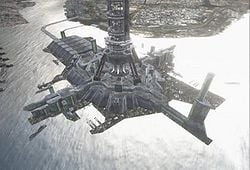
In 2302,[5] due to its economic stability and prominent location, New Mombasa—at that time the world's busiest sea port—was chosen to be Earth's first space elevator city. The elevator transformed the city; New Mombasa became one of the most important cities on Earth.[6]
Over the next eleven years the city experienced explosive growth, but nothing compared to what followed. The city grew out as well as up, its urban sprawl unequaled throughout the continent.[5]
By 2430, New Mombasa had absorbed the entire island and many of the surrounding towns, which became overrun by residents of Mombasa. The switch of name was never official, and though many of the neighborhoods within direct line of sight to the Mombasa Tether still distributed newspapers and chatter directories under their previous names, all municipalities within a 74-kilometer radius of the island became referred to as "Old Mombasa".[5]
The Covenant invasion
- "This is the only place on Earth the Covenant decided to land. That Prophet is going to tell us why."
- — Fleet Admiral Terrence Hood[3]
- Main article: Battle of Mombasa
On October 20th, 2552, a small fleet of Covenant capital ships exited Slipspace just off of Earth's defensive network. During the ensuing battle, a Covenant CAS-class assault carrier, Solemn Penance breached the orbital fortifications and made its way to the surface. The ship, which carried the Covenant Hierarch known as the High Prophet of Regret, took position over the Uplift Nature Reserve.[7] In Old Mombasa, announcements in Swahili were broadcast over a public address system. These propagandist announcements encouraged New Mombasa's citizens to fight against the invading "alien zealots"; even though there was very little truth to these announcements as they were only intended to increase the morale of the population.[8]
Later that day, Master Chief Petty Officer John-117 was deployed into Old Mombasa to assist UNSC forces to liberate the city from the Covenant. After fighting through the maze-like streets of the mainland, the Master Chief crossed the empty beach below the seawall and then entered the highway system and the bridge to New Mombasa. After a series of quick battles in a public park and the city streets, the Chief boarded and destroyed a Covenant Scarab as it passed through the city's artificial canals. After destroying the Scarab, the Chief returned to the UNSC In Amber Clad. At this point, the Covenant troops were retreating back into the Solemn Penance, which was preparing to leave.[9]
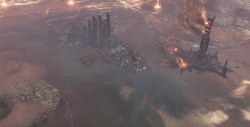
Meanwhile, in orbit, an ODST task force was preparing to hot-drop onto the carrier. While the ODSTs were on their way down, Solemn Penance jumped into slipspace, with the In Amber Clad in pursuit.[10] The ensuing shockwave and EMP engulfed the whole city, causing heavy damage to its digital infrastructure, and scattering the ODSTs' drop pods around the city; at least the six members of Buck's squad survived landing. Although the whole of Mombasa Island was consumed by the explosion, only some buildings close to the Slipspace vortex were sucked through.[11] The slipspace rupture also created a large crater to the mainland, north of Mombasa Island. This was where the Covenant would eventually begin their excavation for the Forerunner structure under the region.[10]
After the slipspace event, a Covenant Jiralhanae-operated fleet arrived at Earth, inserting an occupation force into the city in order to capture Vergil, under orders from the High Prophet of Truth.[12] The remaining UNSC Marines and NMPD fought against the Covenant occupiers for the rest of the day. Eventually, the fleet bore down over the city, glassing the northern sectors in order to uncover the Forerunner structure the city was built over.[13]
Post-war
Though New Mombasa suffered extreme damage from the Covenant invasion, after the Human-Covenant War, Project Rebirth aimed to rebuild and revitalize the city.[14]
Geography
A large seawall was constructed around Mombasa Island at some point, altering its coastline considerably. The northern side of the island retained more of its original width than the southern part, which was much more narrow and symmetrically bordered by the seawall. The narrow southern half housed the city center and Tanaga districts of the city, while on the northern side, industrial structures and docks were more prevalent.[10] A highway ran along the seawall.[13]
The majority of New Mombasa is divided into numbered, symmetrical sectors to limit human casualties and property damage, should disaster befall the city's space tether.[15] Despite this, some districts such as Mbaraki, Kizingo or Kikowani still retain their original names. The original names are often seen in the names of streets or train stations, for example. Some of the districts' names have changed, albeit slightly; areas originally referred to as Tangana and Liwatoni are now referred to as Tanaga and Liwitoni, respectively. The locations of some districts have changed as well. This is the case with most of the districts on the southern side of the island, where the sea has claimed large areas of land.[16]
A massive suspension bridge connected the northern side of the island to the mainland. Starting at some point near the city center, the highway NM 105 E led over the bridge, to the old city and beyond. Near the end of the bridge on the island was New Mombasa's industrial district. This area housed many massive industrial buildings, some with sky bridges connecting them.[3][9]
City center
The city center was a large area. It covered Tanaga and the entirety of the south-east portion of the island.[notes 1]
Tanaga was elevated above the surrounding terrain and housed a concentration of gigantic skyscrapers, the highest - the Vyrant Telecom tower - being over two kilometers tall.[notes 2] At the southeast end of Tanaga there were several medium-sized skyscrapers; the NMPD Headquarters was located here.[10]
Southeast of the arcology wall, the layout of the city was near-symmetrical, and was divided to ten sectors. The Office of Naval Intelligence had their EAP headquarters and research building on the southeast end of the island. The main building was surrounded by a pool of water and an additional wall similar to the sea wall surrounding the whole island. Southeast of the city center, Uplift Nature Reserve, a large park and a wildlife reserve, was located on a series of circular, artificial islands.[7]
Other
Northeast of the Alpha Site, a large artificial island housed the orbital elevator. This island was full of port structures, including warehouses, docks and cranes.[10]
The city also contained a massive network of underground installations, such as the Superintendent's data center deep beneath the surface. The facility consisted of at least twelve sublevels, with the AI's data core residing on the tenth sublevel in a massive cavern with an underground lake on the bottom.[17] Secretly from the general populace, the facility was used to conduct research on a subterranean Forerunner artifact, which was later revealed to be a small section of the Portal at Voi.[18]
An industrial wasteland was also present on the outskirts of the city, and was home to a decommissioned UNSC munitions testing complex.[19]
Industrial zone |
Other
|
Government

The city's most senior government figure was the Mayor of New Mombasa.[14] The New Mombasa Police Department (NMPD) was the organization charged with law enforcement. By the time of the Battle of Mombasa, it was under the leadership of Commissioner Kinsler.
The New Mombasa Transit Authority (NMTA) was charged with the maintenance of public transport in the city.[20] New Mombasa Waste Management (NMWM) was responsible for city sanitation,[3] while New Mombasa Parks and Recreation (NMPR) was responsible for parks and recreational areas.[13] The Superintendent was heavily involved in all areas of administration.
Production notes
The city of New Mombasa has seen considerably different depictions in different pieces of Halo media over the years. However, certain themes have carried over throughout the different iterations; namely the angular, geometric architecture on the whole as well as a number of minor details, like the distinct surface patterning of the roadways or the design of the traffic lights.
Halo 2 E3 demo
In the E3 presentation of Halo 2, the city appeared vastly different than its later versions. The Mombasa Tether was nowhere to be found. Instead, the space elevator's site in the heart of the city was occupied by a massive arcology shaped like an African baobab tree, composed of multiple "decks" covered in massive skyscrapers, and surrounded by urban sprawl. The city was much larger than its future incarnations, with the urban metropolis sprawling into the horizon as far as one could see. The internal architecture and layout of the city also differed greatly in the final version of Halo 2.[21]
The massive tree-like structure from the Halo 2 E3 demo has been used several times in subsequent Halo media. In Halo 2, it can be seen as an Easter egg when looking at reflections in large enough glass windows in maps set in New Mombasa, such as at the ground floor of the building with the giant soccer ball in Metropolis or the large glass side of one of the buildings in the multiplayer level Headlong. In Halo Legends Origins Part I, the design is used to represent a Forerunner structure covered in Flood biomass.[22] Likewise, a similar structure is present in the colony development sequence in Part II of Origins.
Halo 2
In Halo 2, the city was shaped much like its real-world counterpart, with the metropolis residing on the Mombasa island instead of the whole surrounding area having been filled with a gargantuan megalopolis. The massive central structure from the E3 demo was scrapped because the designers wanted New Mombasa to feel more like a real city.[23]
The space elevator was located in the city center, surrounded by massive skyscrapers. A large artificial canal cut through the island, built to house dock facilities for the space elevator. The city's streets appeared more simple and plain than in the E3 Demo, although with more trees and plants. The color palette was also different, now mostly featuring shades of light brown instead of the mostly gray city in the E3 demo.[9] An effort had been made to try to design the city as realistically as possible, using photographs of the current-day city as reference material and envisioning what the city would look like after 500 years of advancement.[23]
New Mombasa is the setting of the level Metropolis, in which the player crosses the massive suspension bridge from Old Mombasa to the Mombasa Island, following a Covenant Scarab headed into the city. After traversing the highway tunnel and Kilindini Park, they push through a section of the city's industrial zone. There, they come face to face with the Scarab which is eventually trapped in the canals facing the space tether and is destroyed by the player, moments before Regret flees the city with the In Amber Clad in pursuit.
Halo 3
New Mombasa is not seen for much of the duration of Halo 3, but if one looks across from the Portal they can see the smoking ruins of the city in the distance. Most of the action on the ground takes place around the market city of Voi instead.[24] Also, a prominent sight throughout the campaign is the sprawling remains of the Mombasa Space Tether, whose mammoth rings collapsed all across the countryside surrounding it and Voi upon the tether's collapse in the earlier engagements.
Halo 3: ODST
Originally, it was assumed that the slipspace jump of the Prophet of Regret's assault carrier had completely destroyed the city, creating the crater seen later in Halo 3. It was revealed in Halo 3: ODST that it did in fact create a crater, although much smaller than what was originally assumed, while the rest of the city survived mostly undamaged. The initial crater, located north of the Mombasa Island, was where the Covenant began their excavation of the Forerunner structure, the Portal, as seen in the Halo 3: ODST level Kikowani Station.
Halo 3: ODST introduces considerable changes to the city. Unlike Metropolis in Halo 2, which was set on the northern side of the city, all gameplay spaces in ODST are located on the southern part of the island. While the areas seen in Halo 2 are not visited nor clearly seen at any point, the city's in-game model from in the level Prepare to Drop has significant differences to the Halo 2 version; namely, the absence of the large canal cutting into the island, as well as the bridge crossed in Metropolis. The northwest side of the island now also has a different overall shape than the Halo 2 version, which mostly followed the shape of the real-world Mombasa Island. However, the absence of most of the canal and the bridge seen in Halo 2 can be attributed to the fact ODST takes place on the other side of the city. The locations seen in Halo 2 are never visited nor meant to be seen, and are thus not modeled in-game even if they still exist in the fiction.
The skyscrapers in the city appear more sleek than the gargantuan industrial complexes in Halo 2, and are very similar to those later seen in the city of New Alexandria on Reach in Halo: Reach. The city center, itself part of a walled, arcology-like complex, now also has a more clearly defined skyline, with a series of thin skyscrapers increasing evenly in height toward the Vyrant Telecom headquarters at the center. Another prominent addition is a massive ONI complex in the southeastern end of the city. The orbital elevator's base has also been moved, and now resides on a small island away from the city center. Its base structure is different, notably being less massive in size than in Halo 2. The internal architecture of the city is much more detailed, with the streets ramping up and down and elevated walkways surrounding them.
Most of the action in ODST takes place within a symmetrically designed "hub" area between the city center and ONI Alpha Site complex, although certain levels take the player to the Uplift Reserve, into the ONI complex, the data center underneath the city, as well as the Waterfront Highway on the island's seawall.
Halo: Reach
 This section needs expansion. You can help Halopedia by expanding it.
This section needs expansion. You can help Halopedia by expanding it.
Halo 2: Anniversary
Halo 2: Anniversary ignores the Halo 3: ODST restructuring of New Mombasa, instead building the remastering upon the layout seen in Halo 2 with major landmarks like the Mombasa Tether in their original locations and ODST's sleek skyscrapers nowhere to be seen. Like in the original Halo 2, the immediate surroundings of the city to the north and the northeast are depicted as an empty desert, rather than the expansive urban sprawl seen in ODST and described in supplemental material.[5]
Trivia
- The New Mombasa emblem features a body of water to the bottom right of the lion. This is actually a mirrored outline of the Chesapeake Bay located in the United States.

|
Browse more images in this article's gallery page. |
Gallery
Concept art and modeling
Early concept art of New Mombasa for Halo 2.
An early overview of the city's urban area for Halo 3: ODST.
An abandoned parking lot during the Battle of Mombasa.
A vandalized UNSC recruitment kiosk during the Battle of Mombasa.
Iconography
Maps/Birds-eye views
Images of the city
An overview of the bridge connecting Old Mombasa and New Mombasa.
The electromagnetic pulse created by the Solemn Penance's in-atmosphere slipspace jump engulfs the city.
The city in the "Keep it Clean" teaser.
Panorama of the area surrounding Tayari Plaza in the slipspace rupture's aftermath.
Panorama of the New Mombasa skyline, as viewed from the Uplift Nature Reserve.
New Mombasa being glassed.
A construction site in Section 21 during the Battle of Mombasa.
- H2A - Mombasa.png
New Mombasa as it appears in Halo 2: Anniversary.
New Mombasa in the Anniversary version of Another Day at the Beach.
List of appearances
- i love bees (First mentioned)
- Halo 2 (First appearance)
- Halo Graphic Novel
- Halo: Ghosts of Onyx (Mentioned only)
- Halo: Uprising (Mentioned only)
- Halo 3
- Halo 3: ODST
- Halo: Evolutions - Essential Tales of the Halo Universe
- Halo Reach
- Halo 4 (Mentioned only)
- Halo 2: Anniversary
- Halo: New Blood
- Hunt the Truth (Mentioned only)
- Halo: Hunters in the Dark (Mentioned only)
- Halo 5: Guardians (Emblem only)
- Halo Mythos
- Halo Wars 2 (Mentioned only)
- Halo: Envoy (Mentioned only)
- Halo: Legacy of Onyx (Mentioned only)
- Halo: Bad Blood (Mentioned only)
- Halo: Renegades
Notes
- ^ In Sadie's Story, multiple areas seen in the ODST campaign are referred to as the city center. This includes Kikowani Station (Audio log 1, Circle 1, Arc 1), ONI Alpha Site and the New Mombasa Data Center (Audio log 8, Circle 3, Arc 2), the NMPD Headquarters (Audio log 24, Circle 8, Arc 3), and the area in which the Solemn Penance arrived at (Audio log 3, Circle 1, Arc 3).
- ^ Measurable through using pan-cam coordinates. 1 WU is roughly equal to 3 meters. The height cap is at 615 WU, and the building extends slightly over this limit.
Sources
- ^ Halo: The Essential Visual Guide, p. 191
- ^ Bungie.net, Halo 3: ODST Field Guide
- ^ a b c d Halo 2, campaign level, Outskirts
- ^ Wikipedia: Mombasa
- ^ a b c d Bungie.net: Halo 3: ODST Field Guide: New Mombasa
- ^ Halo Waypoint, "Space Elevator" article (Archived on Archive.org)
- ^ a b Halo 3: ODST, campaign level, Uplift Reserve
- ^ Halo.Bungie.org: Halo 2 Dialogue Snippets - Snippets of Swahili
- ^ a b c Halo 2, campaign level, Metropolis
- ^ a b c d e Halo 3: ODST, campaign level, Prepare to Drop
- ^ Halo 2, campaign level, Delta Halo
- ^ Halo Waypoint, "Ten Twenty" article
- ^ a b c Halo 3: ODST, campaign level, Coastal Highway
- ^ a b McFarlane Toys/Halo Point Prizes, Master Chief Statue Press Release
- ^ Halo: Evolutions - Essential Tales of the Halo Universe, "Palace Hotel", p. 366
- ^ Halo 3: ODST, campaign level, Mombasa Streets
- ^ Halo 3: ODST, campaign level, Data Hive
- ^ Halo: The Essential Visual Guide, p. 132
- ^ Bungie.net: An Affinity for Art - "Tombstone's grim horizon is a reminder that New Mombasa fared badly in the Covenant assault on Earth."
- ^ Halo 2, multiplayer level, Terminal
- ^ Halo 2 E3 Demo
- ^ Halo Legends, Origins (Screenshot)
- ^ a b YouTube: First Look Halo 2
- ^ Halo 3, campaign levels, Tsavo Highway and The Storm
